Exploring Kiteboarding Stores: A Comprehensive Analysis
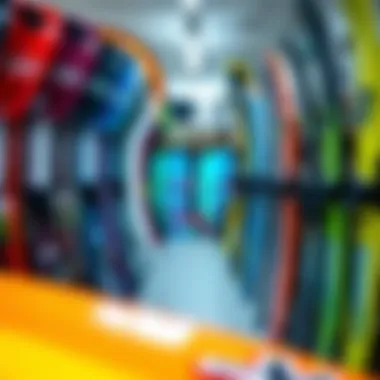
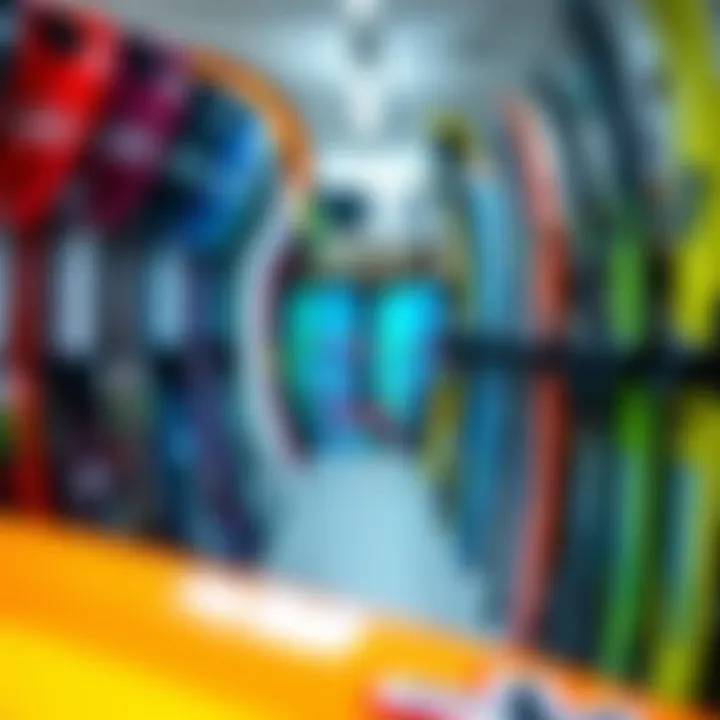
Intro
Kiteboarding has surged in popularity, drawing in adventurers from all walks of life. The sport's appeal lies not just in the thrill but also in the vibrant culture surrounding it. A pivotal part of this culture is the kiteboarding store, where enthusiasts gather not just to gear up but also to share experiences and knowledge. These local shops often serve as community hubs, making them essential for both novice riders and seasoned veterans.
Kiteboarding stores offer a gateway to a myriad of products, ranging from various types of kites to boards that cater to different riding styles. Understanding these products is crucial for any kiteboarder embarking on their journey. Retail spaces play a significant role in shaping the community culture and can greatly influence a rider's experience on the water. Each local shop carries its unique essence, often reflecting the preferences of the riders in that area, which can drastically affect one’s choice in gear.
Furthermore, with the rapid evolution of technology in kiteboarding gear, new advancements continuously redefine what is available in stores. This development requires riders to make informed purchasing decisions based on practical knowledge rather than trends. This article aims to navigate the complexities of kiteboarding retail by highlighting key aspects such as gear selection, skill development, and much more, providing valuable insights for our readers.
Understanding Kiteboarding Stores
Kiteboarding is more than just a hobby; it’s a way of life for many. This makes understanding kiteboarding stores essential for enthusiasts who want to delve deeper into the culture surrounding this exhilarating sport. Kiteboarding stores serve as vital nerve centers for the community, providing not only equipment but also guidance and a sense of belonging. Each facet of this retail experience contributes to the rider's journey, forging connections that go beyond mere transactions.
In the world of kiteboarding, having the right gear is crucial. Kiteboarding stores offer an array of products tailored to various skill levels and preferences. But they fulfill a broader purpose too, acting as social hubs where enthusiasts gather to exchange tips, share experiences, and foster community spirit. The guidance offered in these stores can be the difference between a novice struggling with their setup and a seasoned rider maximizing performance.
Definition and Purpose
Kiteboarding stores are specialized retail outlets dedicated to the sport of kiteboarding. They offer products ranging from kites and boards to safety gear and apparel. The primary purpose of these stores transcends simply selling equipment. They educate customers about the gear, teach best practices, and often recommend the right equipment tailored to a rider's skill level and style.
Within their walls, a wealth of information awaits. Knowledgeable staff members can explain the intricacies of gear selection, maintenance, and safety protocols. They are often experienced kiteboarders themselves, able to provide insights that can’t be found online. This direct interaction creates an enriching experience that's both informative and supportive, particularly for newcomers looking for guidance in the sport.
Historical Context
The journey of kiteboarding stores parallels the evolution of kiteboarding as a sport. Kiteboarding originated in the late 20th century, but it didn’t have dedicated shops until its popularity surged in the early 2000s. Initially, enthusiasts often crafted their equipment or imported it from niche markets. As interest ballooned, the demand for specialized stores became evident.
Over the years, brands like Slingshot and Cab Rival emerged as household names among kiteboarders, leading to an influx of retail shops devoted to these products. With a growing framework, stores transitioned from selling basic gear to providing comprehensive services like training sessions, demo days, and community events. Today, these shops not only sell items but also actively engage customers in the sport itself.
This historical backdrop highlights how kiteboarding stores have adapted alongside the sport, establishing themselves as pillars of the kiteboarding community. They are not just places to buy equipment; they are part of the tapestry that forms the experience of kiteboarding.
"Kiteboarding is not merely about the ride; it's about the community that supports it." This sentiment resonates through every kiteboarding store, encapsulating the essence of the sport.
Types of Products Available
The Types of Products Available in kiteboarding stores form the backbone of the sport's vibrant ecosystem. For both newcomers and seasoned riders, understanding the range of products can vastly enhance one’s experience on the water. Whether you are in it for the thrill or the artistry of kiteboarding, proper equipment ensures safety and performance.
Kites
Kites are, without a doubt, the heart of kiteboarding. When choosing a kite, various factors come into play—size, type, and design. First, the size of a kite largely depends on the rider's weight and wind conditions. A lighter person may prefer a smaller kite for optimal control, while heftier individuals can effectively handle larger models. Similarly, kites are generally classified into categories such as inflatable and foil kites. Inflatable kites are known for their stability and ease of use, which can be beneficial for beginners; whereas foil kites offer sleek designs that help advanced riders in optimizing performance in light winds.
Moreover, it’s worth mentioning the design aspects. Some kites are designed for high performance and tricking, while others provide a more stable ride geared towards beginners. By assessing your needs, you can select a kite that complements your skill level and riding style.
Boards
Next up are kiteboarding boards, which play a vital role in how effectively a rider harnesses the kite's power. Different types of boards are tailored for various riding styles, including twin-tip, directional, and foil boards. Twin-tip boards, easily recognizable by their symmetrical shape, are immensely popular among freestyle riders seeking to perform tricks and jumps. On the contrary, directional boards are often favored by those who enjoy surf-style riding. They are designed to be ridden in one direction and mimic the feel of surfing, enhancing the overall ride experience on waves.
Considerations such as board material also matter. Most boards are made from fiberglass or carbon. While fiberglass boards offer durability and are easier on the wallet, carbon boards tend to be lighter and provide enhanced performance. Making the right selection based on your riding style can lead to years of enjoyable sessions on the water.
Safety Gear
Safety gear is a non-negotiable aspect of kiteboarding. Helmets, impact vests, and wrist guards are just a few items that can dramatically reduce the risk of injury. A properly fitted helmet protects against unexpected falls and collisions, while an impact vest can cushion during hard landings and provide buoyancy, keeping a rider afloat if they find themselves in deep water.
Additionally, opt for harnesses that suit your comfort. There are seat harnesses as well as waist harnesses, with the latter often preferred for their freedom of movement. Quality safety gear not only ensures a safer riding experience but promotes confidence, allowing for bolder maneuvers.
Accessories and Apparel
Lastly, accessories and apparel round off the kiteboarding experience. Items like leashes, foot straps, and kite bags are essential for both safety and convenience. A reliable kite bag ensures easy transport of your gear, keeping everything organized and secure. Foot straps should be adjustable, allowing you to tighten or loosen them according to your preferences, ensuring that your feet stay securely in place while performing tricks.
Furthermore, don’t overlook clothing specifically designed for kiteboarding. Quick-dry and UV-protective apparel can help keep you comfortable and protected from the elements, especially since you could be exposed to sun and wind for extended periods. Investing in high-quality accessories further enhances performance and safety, making them vital purchases on your journey into kiteboarding.
As we progress, it's clear that the nature of products available at kiteboarding stores impacts riders significantly. The right gear not only enhances performance and safety but elevates the entire kiteboarding journey. With an abundance of choices, it is paramount to choose wisely, as each piece of equipment plays its part in your experience.
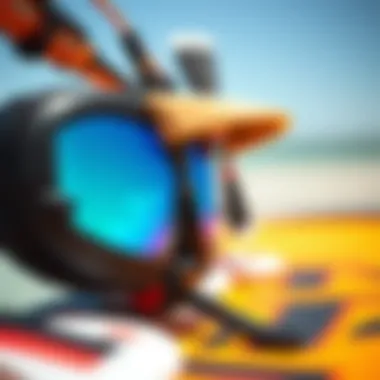
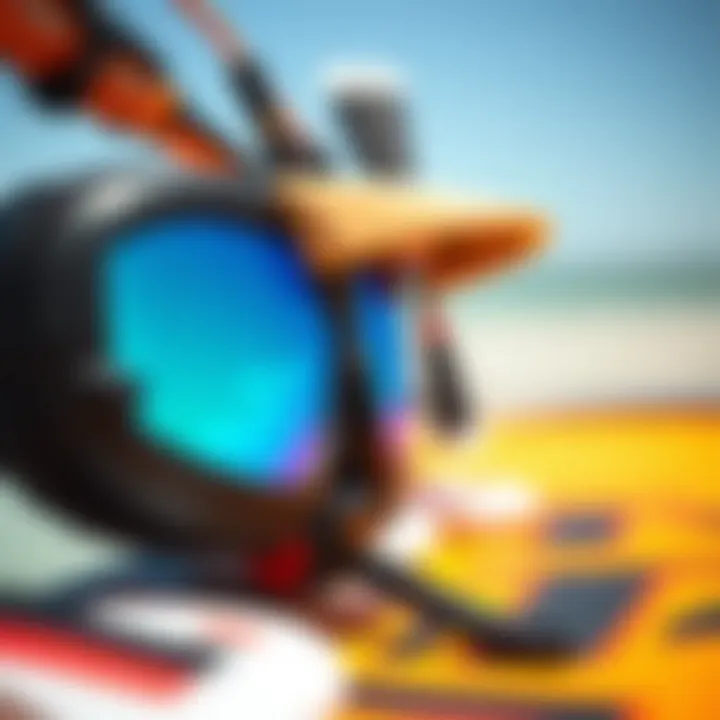
The Role of Retail in Kiteboarding Culture
Retail shops in kiteboarding are more than just places to pick up equipment. They form a critical backbone for the kiteboarding community, fostering connections among enthusiasts while providing vital resources. As kiteboarding grows, the role of these stores evolves, but their importance remains clearly defined.
Community Engagement
Kiteboarding stores are hubs of activity, inviting participation from both seasoned riders and newcomers. These shops often host local gatherings, which allow kiteboarders to share experiences, tips, and knowledge. It’s not uncommon to find customers just hanging out, swapping stories about their latest sessions or discussing the best spots to catch the wind.
Additionally, many stores become sponsors for local teams and events. This sponsorship plays a pivotal role in building and sustaining local talent. When a shop backs a tournament, it doesn’t just help with finances; it also boosts community spirit. Riders feel more connected, and as a result, the community thrives. Stores like KiteWorld often use social media to advertise these events, making sure everyone is in the loop.
Engaging with the community also comes through loyalty programs. For instance, offering discounts to frequent customers can turn shoppers into dedicated patrons and friends. This relationship strengthens the ties within the kiteboarding community, creating a network where sharing valuable information holds more significance than just buying equipment.
Local Competitions and Events
Kiteboarding thrives on competition. It gives riders a reason to push their limits and improve their skills. Local shops often take the reins in organizing contests, like freestyle or race events, creating a direct connection between retail and rider motivation. By providing venues, equipment, and marketing, these retailers enable athletes to showcase their prowess.
Moreover, local competitions draw spectators and potential new riders, enhancing the visibility of kiteboarding as a sport. Shops like Surf Paradise Kite Shop not only supply kites and boards, but they also set up infrastructure for competitions, like registration booths and scoring systems. This participation doesn’t just help the sport; it puts the store at the heart of the action, fostering a sense of belonging.
In these settings, local businesses can shine, contributing to both the culture of kiteboarding and their bottom line. You can find families cheering from the sidelines, enjoying a vibrant atmosphere that brings together the community every season.
Workshops and Training Sessions
Education is the lifeblood of any sport, and kiteboarding is no exception. Retail shops frequently offer workshops and training sessions, often led by experienced instructors or sponsored riders. Through these initiatives, shops can cultivate a knowledgeable kiting culture.
Whether it's a workshop on technical kite maintenance or a training session for beginners wanting to learn the basics, the opportunities are bountiful. Take Kite City, for example, which might host workshops on how to choose the right equipment or improve flying techniques. Such sessions provide immense value, ensuring that new riders have a solid foundation to build upon.
Additionally, training sessions can often lead to partnerships with schools and clubs. Retailers might team up with local organizations to run kiteboarding camps, which not only attract new customers but foster long-term loyalty. Offering structured learning paths helps riders progress from novices to champions, benefiting the entire kiteboarding culture in the process.
Through community engagement, local competitions, and educational workshops, retail shops transcend commerce. They cement their place as vital contributors in nurturing the kiteboarding culture, ensuring that it not only survives but thrives.
Navigating Product Choices
In the world of kiteboarding, selecting the right gear can feel like searching for a needle in a haystack. The sheer variety of options can be overwhelming for beginners and seasoned riders alike. Understanding how to navigate the myriad of product choices is essential. It ensures that you get equipment suited to your skill level, riding style, and preferences.
Evaluating Quality
When it comes to kiteboarding gear, quality is paramount. Even a slight malfunction in your kite or board during a ride can lead to serious accidents. Look for brands known for their durability and performance. For instance, high-quality kites often use materials like ripstop nylon, which are lightweight yet resistant to tears and abrasions. Furthermore, the stitching on kites should be robust, as poor stitching can lead to flaws over time.
It’s advantageous to invest some elbow grease into researching products before making a purchase. Check reviews from kiteboarding forums and communities like Reddit for firsthand accounts from riders. Many experienced enthusiasts share their insights on everything from performance to longevity. Also, more prominent stores often allow you to test gear before buying, which can provide the assurance that your investment is sound.
Understanding Brands and Their Reputation
Every kiteboarding enthusiast likely has a favorite brand. However, while personal anecdotes are valuable, diving deeper into the brand's reputation is essential before deciding. For example, names like North Kiteboarding and Cabrinha carry weight because of their long histories in the industry. They've earned a reputation for crafting reliable equipment that meets high performance standards.
Another aspect to consider is how brands respond to safety concerns. Some companies participate in organizations that promote safe kiteboarding practices, showcasing a commitment to rider welfare. This involvement can be a significant factor in determining which brand aligns with your values. Furthermore, being aware of a brand’s reputation can also aid in identifying genuine products and avoiding counterfeit gear that could jeopardize safety.
Comparing Price Points
Price is often a deciding factor when shopping for kiteboarding gear. A new kite can range from several hundred to several thousand dollars. Understanding why certain products are priced as they are can lead to smarter purchases.
- Entry-Level Gear: Generally more affordable and suitable for beginners.
- Mid-Range Options: Offer a balance, providing good quality for intermediate riders.
- High-End Products: Designed for advanced users, these often feature cutting-edge technology and materials.
Before making a decision, consider how often you plan to ride and the conditions you’ll typically encounter. If you’re just starting out, buying top-tier gear might be an overcommitment. Instead, look for reliable, mid-range products that won’t break the bank but still offer decent performance.
"Choosing the right gear can make or break your kiteboarding experience. Find the right balance between quality and price—in the long run, it pays off."
Price comparisons can also be aided by online tools that aggregate pricing from various retailers, such as KiteLine or local store websites. Don’t forget to factor in shipping costs and potential import taxes if you're buying internationally.
Navigating these choices effectively will equip you for a successful kiteboarding journey, making your adventures on the water both thrilling and safe.
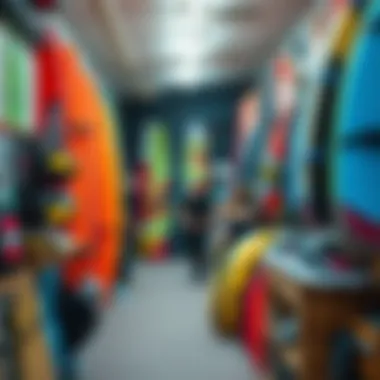

The Evolution of Kiteboarding Gear
The progression of kiteboarding gear has had a significant impact on the sport itself, shaping not just the equipment that riders use but also the overall experience of kiteboarding. Innovations in design and technology have created safer, more efficient, and user-friendly products that cater to both novices and seasoned pros. Understanding the evolution of gear is crucial for kiteboarders, as it reflects the ongoing adaptation of the sport to meet the demands of different riding styles and conditions. With every technological leap, riders can harness the wind in ways they previously could only dream of.
Technological Advancements
In the realm of kiteboarding, technology is akin to magic; it transforms ordinary materials into powerful tools that enhance performance. Modern kites, for instance, have transitioned from rudimentary fabric constructions to advanced materials that are lighter yet stronger—think ripstop nylon and reinforced seams that withstand the rigors of the ocean. Innovations such as zero-pumping kites, where inflation is a breeze, and the emergence of kites with multiple leading-edge designs allow for better control and responsiveness. This not only heightens the thrill but also crucially reduces the time needed to get on the water.
Some other notable advancements include:
- Improved Parachute Design: Many kites now boast a delta shape which provides greater lift, allowing riders to perform tricks and jumps with greater ease.
- Smart Safety Features: Many modern kites come equipped with quick-release mechanisms and safety systems that have revolutionized how riders can enjoy the sport safely.
- Responsive Board Materials: Boards crafted with technologies such as carbon fiber provide increased durability and performance while remaining lightweight, ensuring that every move translates directly into speed and agility on the water.
These advancements significantly enhance the overall kiteboarding experience, allowing riders to push their limits further than ever before.
Trends in Design
Design in kiteboarding has evolved over the years, responding not only to functionality but also to aesthetic desires within the community. The look of the gear has become as important as its performance capabilities. Bright, bold colors and striking patterns are not just about making a statement; they help in visibility, which enhances safety in crowded waters.
Moreover, there are several trends worth discussing:
- Customization: Alongside performance, there's been a surge in gear customization. Many shops now offer personalized fittings, enabling riders to tailor their equipment to their specific style and preferences.
- Eco-Friendly Materials: With increased awareness around environmental impact, several companies are now using sustainable materials to create kites and boards. This approach not only helps the planet but also appeals to a growing base of environmentally conscious consumers.
- Emphasis on Versatility: New designs are focusing on creating multi-functional equipment that can be used in a variety of conditions, catering to different styles—from freestyle to surf.
"The best equipment is the one that feels like an extension of yourself, harmonizing with the wind and water to create a seamless riding experience."
As kiteboarding continues to evolve, the marriage of technology and innovative design not only magnifies performance but also deepens the personal relationship riders have with their sport. For enthusiasts and competitors alike, staying abreast of these changes is essential; it can make all the difference in how they engage with the waves and the wind.
Online versus Local Stores
When it comes to purchasing kiteboarding gear, the choice between online and local stores can feel like deciding between riding a wave or catching a gust of wind. Each option presents its own set of advantages and challenges, and how you approach this decision can significantly impact your kiteboarding experience.
Benefits of Local Shops
Local kiteboarding shops are more than just retail outlets; they're hubs for the community, positioned right in the heart of where the action is.
- Personalized Service: Local shops typically offer one-on-one interactions with knowledgeable staff. You can often ask specific questions about gear and receive tailored advice based on your individual skill level and preferences. This level of interaction can be invaluable, especially for beginners who might feel a bit lost among all the options.
- Try Before You Buy: Many local shops allow you to test equipment in-store or even rent gear for a day. Trying out kites or boards firsthand can help ensure that you pick the right fit before making a purchase.
- Community Connection: Local stores frequently offer workshops and hold events, bringing together enthusiasts to share tips, tricks, and experiences. This fosters a sense of belonging and community, which is often lacking in the online shopping experience.
Advantages of Online Retail
On the flip side, online retail has transformed the way we acquire kiteboarding gear, offering benefits that local shops might struggle to match.
- Convenience: Shopping from the comfort of your couch means you can browse thousands of products without leaving your home. Online stores are open 24/7, allowing you to shop whenever it suits you. This can be especially appealing for busy instructors or event organizers who might not have the time to visit physical locations.
- Wider Selection: Online stores often have a more extensive inventory than local shops. If you're looking for a specific brand or model, the chances are higher online. This allows you to compare different options and prices effectively, potentially saving you money.
- Reviews and Ratings: Online shopping platforms often feature user reviews. Seeing feedback from other kiteboarders can provide insight into product performance and help you make informed decisions.
Hybrid Buying Experiences
The best of both worlds might just be the hybrid shopping experience, which is gaining traction among kiteboarding consumers.
- Research Online, Buy Local: Many enthusiasts leverage online resources to research products before making a trip to a local shop. This not only prepares them for what to expect but also makes conversations with local staff more productive.
- Click and Collect: Some local shops now offer online ordering with the option to pick up in-store. This way, you can secure your purchase ahead of time and avoid shipping fees while still benefiting from local store advisors.
- Online Engagement: Many local businesses have expanded their reach through online platforms, offering social media interaction or virtual workshops. This helps maintain community ties while still adapting to the digital era.
"Whether online or in-store, engaging with fellow kiteboarders and knowledgeable retailers ultimately enriches the purchasing experience."
Safety Protocols and Equipment Regulations
Importance of Compliance
In the exhilarating world of kiteboarding, safety is the name of the game. Compliance with safety protocols and equipment regulations isn't just a matter of adhering to rules; it can make the difference between a fun day out on the water and a trip to the emergency room. That’s why understanding these protocols is crucial for riders of all levels.
Adhering to these regulations ensures that gear meets certain standards, which can significantly reduce risks. Kites, for instance, undergo various tests to confirm they can withstand stress and sudden impacts. This isn't just about protecting you, the rider; it also safeguards others who might be enjoying the same waters.
Every kiteboarder may have his own story of how a faulty piece of gear led to an unexpected mishap. Many of these stories underscore the importance of using compliant products that have been certified by reputable organizations. When equipment fails, it can lead to serious injuries not just for the rider, but also for bystanders or fellow enthusiasts.


Key factors that emphasize the importance of compliance include:
- Increased Safety: Properly regulated equipment minimizes the risk of accidents.
- Insurance Requirements: Many insurance providers require proof of compliance with safety standards before coverage kicks in, so not complying can leave you without financial backup in a pinch.
- Peace of Mind: There's something to be said about the comfort of knowing your gear meets industry standards. When you’re out there gliding over waves, the last thing on your mind should be whether your kite is going to hold up.
A commitment to these protocols is a clear testament to a kiteboarder's professionalism and dedication, enhancing not just individual rider safety but contributing positively to the culture as a whole.
Store Participation in Safety Programs
Kiteboarding stores play an indispensable role when it comes to promoting safety within the community. Engaging in various safety programs not only enhances the store's reputation but also empowers riders. When a store actively participates in safety programs, it can help foster a culture of safety among beginners and seasoned kiteboarders alike.
By holding workshops that focus on safety gear and protocols, kiteboarding stores take significant strides towards improving overall community safety. These workshops often cover:
- Proper Equipment Use: Teaching customers how to use their gear correctly can prevent injuries caused by misuse.
- Regular Maintenance Checks: Educating riders on when and how to check their equipment can extend the lifespan of their gear and keep them out of trouble.
- Emergency Response Strategies: Providing training on what to do in emergencies prepares riders to react calmly when things go awry.
Additionally, stores often align themselves with local or national safety organizations. This participation can manifest in various forms, such as sponsoring events dedicated to safety awareness or collaborating with instructors to promote safe riding techniques.
“A kiteboarding store committed to safety isn’t just selling gear; they’re investing in the community.”
The ripple effect of these initiatives cannot be understated. A knowledgeable shop employee can influence a customer’s understanding of safety protocols fundamentally. When customers see a store prioritizing safety, it sends a strong message that this sport is not just about thrills but also about responsibility.
By integrating safety into their core operations, kiteboarding stores ensure that every purchase, every lesson, and every event is aligned with the well-being of the entire kiteboarding community. The bottom line is that when stores invest in these safety programs, they are not only protecting lives but also enriching the sport for everyone involved.
Environmental Considerations in Kiteboarding Retail
As the popularity of kiteboarding surges, so does the need to address the environmental ramifications tied to the sport. Skateboarders find joy riding the waves and winds, but they must also consider the impact their activities have on nature. Focusing on environmental considerations in kiteboarding retail is essential not just for the sustainability of the sport itself, but also for the overall preservation of the ecosystems where kiteboarding occurs. This section will delve into sustainable product practices and community initiatives for conservation, emphasizing their importance for both the industry and the enthusiasts.
Sustainable Product Practices
Sustainable product practices in kiteboarding encompass a range of efforts made by manufacturers and retailers to mitigate environmental hazards. This includes:
- Material Sourcing: Companies are now looking into eco-friendly materials, like recycled plastics and organic fabrics for kites and gear. For example, brands such as North Kiteboarding utilize materials that reduce waste while delivering high performance.
- Manufacturing Processes: Adopting practices that minimize carbon footprints is crucial. Some manufacturers are shifting to production methods that rely on renewable energy or lower emissions which directly benefit our planet.
- End-of-Life Solutions: There’s a growing trend to offer recycling programs for old kites and boards. Rather than ending up in landfills, discarded gear can be repurposed, which is a win-win for the community and the environment.
By making purchasing decisions based on sustainable product practices, kiteboarders contribute to the preservation of their beloved sport and natural landscapes, promoting a healthier future.
"Choosing eco-friendly gear is as important as mastering the winds; it helps ensure the beauty of our kiteboarding spots for generations to come."
Community Initiatives for Conservation
Kiteboarding stores are not merely retail spaces but hubs of community engagement. Many shops are stepping up and leading community initiatives for conservation, showing their dedication to the environment. These initiatives often include:
- Beach Clean-ups: Organizing regular clean-up events allows kiteboarders to actively participate in keeping their riding locations pristine. Many local shops sponsor equipment for these days, fueling community spirit and environmental responsibility.
- Environmental Awareness Workshops: Workshops are held in stores to educate enthusiasts on how kiteboarding impacts local ecosystems. This helps riders understand their role in protecting the environment.
- Partnerships with Environmental Organizations: Many stores collaborate with non-profits focused on preserving ocean habitats, helping to promote broader ecological efforts and advocacy work.
Through these community initiatives, kiteboarding stores play a pivotal role in ensuring that the beauty of nature is preserved while also enriching the bond among local kiteboarders. All in all, by embracing sustainability, the kiteboarding community can contribute to a thriving and beautiful environment.
Future of Kiteboarding Stores
The kiteboarding industry is riding a wave of rapid change and innovation. Understanding the future of kiteboarding stores is crucial for both enthusiasts and retailers. This section lays bare the transformations happening in the field, focusing on how social trends, technology, and environmental awareness are reshaping retail experiences and product offerings.
Emerging Trends
A couple of factors are steering the course of kiteboarding retail. Firstly, the rise of e-commerce has forced brick-and-mortar stores to rethink their approach. Local shops are not just retail outlets but community hubs where relationships are built. With customers increasingly gravitating towards online shopping, local vendors are merging shopping with experiences. They might host demo days or workshops, where enthusiasts can test gear and learn directly from experts. This creates a vibrant marketplace that fosters engagement and encourages customer loyalty.
Moreover, there’s a pronounced push for sustainability in product choices. Companies are investing in environmentally friendly materials and production processes. Kiteboards made from recycled materials, for example, are gaining popularity. The demand for eco-conscious brands is reflected in changing consumer preferences. Buyers today are looking for products that align with their values, driving stores to curate selections that emphasize sustainability over mere aesthetics.
Other notable trends include the personalization of customer experiences, where stores leverage data analytics to offer tailored advice and products based on previous purchases. Augmented reality tools that allow customers to view kites and boards in their home environment are becoming more common as well. This fusion of technology and retail enhances the shopping experience, making it more interactive and informative.
Predicted Market Changes
As we set our sights on the horizon, it’s apparent that the kiteboarding market will undergo notable shifts. For one, we are likely to see an influx of new brands emerging as entry barriers lower and innovative designs pique consumer interest. Established brands will want to adapt quickly by enhancing their offerings to compete with fresh competitors.
The increase in kiteboarding popularity is also expected to drive product availability. As more people take to the skies, retailers will need to stock a wider range of gear to accommodate diverse skill levels and styles. This could mean more affordable options for beginners, as well as high-performance gear for seasoned riders.
However, with these changes come challenges. The ongoing evolution of e-commerce means that physical stores must constantly adapt. Retailers who rely solely on physical sales could feel the impact, but those embracing an omni-channel approach—merging online and offline experiences—will likely thrive, ensuring they remain at the forefront of the market.
In summary, the future of kiteboarding stores mirrors broader retail dynamics, where technology, community engagement, and sustainability stand out as essential pillars guiding the industry. Retailers willing to embrace these changes will prove adaptable, meeting the expectations of a passionate and environmentally-conscious customer base.
The kiteboarding industry must stay ahead of emerging trends and market shifts to ensure that both retailers and customers benefit from these dynamic changes.















